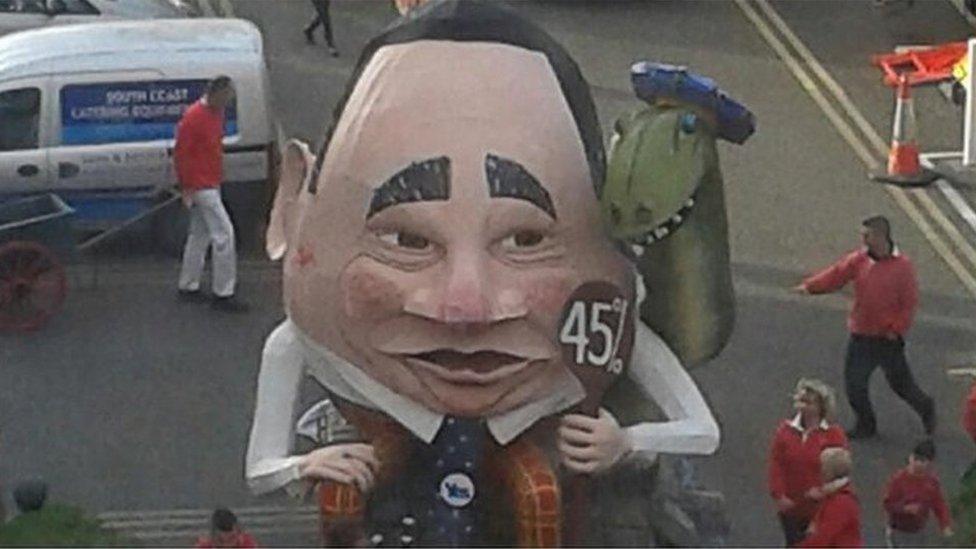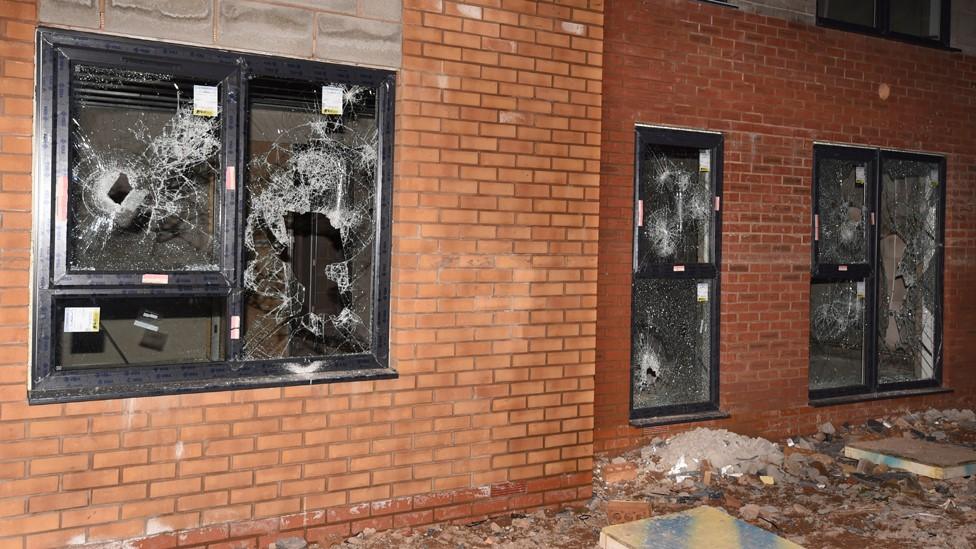Bonfire Night: Why is Guy Fawkes a big deal in Sussex?
- Published

Societies parade through the streets of Lewes at a celebration attended by tens of thousands of people
To some, Bonfire Night represents an excuse to set off some fireworks. But it is perhaps in the south east of England that memories of Guy Fawkes and his failed bid to blow up King James I burn brightest.
The festivities are about far more than one night though. The Sussex Bonfire season starts on the first weekend of September and ends in the third week of November.
Bonfire societies from towns around Sussex and the western edges of Kent capitalise on the fact the events are staggered across several weeks to take part in each other's parades and the biggest nights attract crowds of several thousand.
Flaming torches, costumes and effigies of celebrities are as much a part of the spectacle as fireworks and the almost cult-like Bonfire season is a key part of the calendar in a manner that may seem bizarre to those elsewhere in the country. But why is it such a big deal?

This engraving depicts the 1886 Lewes Bonfire - and some elements look very familiar

To some extent, the answer lies in history stemming back even further than Guy Fawkes's failed bid to blow up the Houses of Parliament in 1605.
The parade in Hastings always falls on a Saturday around 14 October, the date of the Battle of Hastings in 1066.
But the biggest event takes place in Lewes, the county town of East Sussex, and is always held on 5 November.

The 400th anniversary of the foiling of the Gunpowder Plot was celebrated in Lewes in 2005
While Guy Fawkes and the gunpowder plot dominate the UK's autumnal bonfire tradition, Lewes Bonfire Society also remembers the 17 martyrs burnt to death by Mary I in the town in the 1500s.
Each year the market town's population of 18,000 is almost quadrupled for a night, thanks to its international reputation for a captivating torch-lit parade, world class fireworks display and blowing up of effigies.
The event is the result of the combined work of seven bonfire societies, most of which date back to the 19th Century. Each society is located in a different part of town, centred around its own pub, which doubles as an HQ.
Each society has its own costume, with inspiration ranging from the Civil War to World War One, from the Vikings to Waterloo. The most popular costume is that of the smuggler, distinguished by a stripy jumper. This is common to all seven societies, though each society favours different coloured stripes.

The societies in Sussex congregate in Lewes in fancy dress each year
Participants also carry burning barrels and 17 burning crosses. These hark back to the 17 Protestant martyrs who were burnt in Lewes during the reign of Bloody Mary, half a century before Guy Fawkes attempted to blow up the Houses of Parliament.
Mick Symes, captain of ranks for Lewes Borough Bonfire Society, said: "Two societies date back to 1853 but celebrations had been going on for years before that.
"The society I'm with dressed up in blue and white striped jumpers called Guernseys, with white trousers and blue and white hats. Faces were covered with soot and they walked through our town with banners and tableaus.
"Prior to that they ran through with barrels and had ad hoc bonfires in the street."

A Zulu costume used in previous years at the Lewes Bonfire
Despite the obvious introduction of safety regulations and road closures, Lewes's bonfire stays true to its 1853 route, though the style has evolved thanks to the introduction of varying costumes, such as those of Tudors or Zulus, though the latter has attracted criticism in recent years.
Mr Symes said: "We have the same blueprint. We walk down the very same streets.
"The costumes were simply to dress up in something better than a smuggler and with more colour.
"It reflected the British Empire and the world. It has a fabulous history. It is a history of England and our town.
"Each society has its own unique history and they are proud of their traditions.
"When we set off at 10 past six we set off on a slow march to the war memorial. We walk in complete silence and darkness."

John Bercow, Boris Johnson and Jeremy Corbyn were set on fire at Edenbridge's bonfire on Saturday
Across the border in Kent, Edenbridge Bonfire Society famously unveils its effigy each year one week before it is set on fire. This year outgoing Speaker of the House of Commons John Bercow was the figure chosen to go up in flames in effigy form.
Previous politicians and notorious celebrities chosen for the honour have included Boris Johnson, Donald Trump and Saddam Hussein, and Katie Hopkins, Harvey Weinstein and Wayne Rooney.
In Lewes David Cameron, Vladimir Putin and Osama bin Laden have all been burnt in effigy in recent years, along with Alex Salmond, Sepp Blatter and Jeremy Clarkson.
Vladimir Putin sporting a green mankini, a seagull nesting in Brighton and Hove Albion's Amex Stadium and an homage to Neil Armstrong have also been among the incredible and painstaking efforts put together by a dedicated society.
The tableaus the societies build tend to represent a local event or a national or international problem.
Some of the effigies have, perhaps not surprisingly, attracted criticism.

A photograph of an effigy of Alex Salmond caused controversy in 2014
In 2014, in the wake of the referendum over Scottish independence, a photo from Lewes of an intricate tableau portraying SNP politician Alex Salmond, then first minister of Scotland, was leaked on Twitter by East Sussex County Council.
Mr Symes said: "It wasn't making a derogatory statement. He nearly brought about a break up of the UK.
"The Scots got upset and started sending death threats to individual members."

A second effigy of Alex Salmond was also paraded through Lewes
At the time, Mr Salmond said he had no real issue with his replica but was more worried about national icon Nessie being blown up.
Lewes reacted by sparing Nessie the TNT and the monster was replaced by the Twitter logo bird, which met its demise instead.
Jeremy Clarkson showed a desire to "blow himself up" when he was invited to destroy a tableau depicting the fallout that saw him leave his BBC series Top Gear, only for filming in the US to rule him out.

Vladimir Putin was placed onboard a tank while wearing a mankini during one of Lewes's bonfires
But it is perhaps the age-old effigy of the Pope that has been most contentious of all. Lewesians are keen to stress this is not an effigy of the Pope per se, but an effigy specifically of Pope Paul V, who led the Catholic church when those 17 Protestant martyrs were burnt in the town.
And though the roots of this ceremony are anti-Catholic (as is Guy Fawkes Night), its modern incarnation is strictly non-Sectarian. When leading Northern Ireland protestant politician and religious leader Reverend Ian Paisley pitched up in 1981, uninvited, to canvass the crowds, he received a muted welcome. The following year, he was burnt in effigy.

It is the Pope, but it's specifically it's Pope Paul V from the 16th Century
Sussex bonfire societies exist in 2019 in as close as possible the same way as they did in 1853. Mr Symes is quick to praise the way tradition is maintained and passed through the family.
He added: "The societies bounce off each other. Lewes has been the hub of it and people are prepared to travel to other societies.
"We all know each other. It's a big family.
"I will be walking with three of my five daughters, my ex-wife, her husband and my grandchildren.
"You will find families in their fifth and sixth generation. Our president is 78 and he had his first bonfire when he was four. This year his grandson will be carrying a tar barrel."

A man dresses up a dummy Guy Fawkes in preparation for Lewes Bonfire in 1951

Laura Lawrence, of Edenbridge Bonfire Society, said the link between the committee and community played a huge role in making sure the event continues to impress each year.
"The society will be involved in float building and a mother at the school or child involved will continue the tradition by getting involved in the society," she said.
"We need to get the numbers in. We are always encouraging new people to get involved with the committee."
More than 700 people took to the town's streets on Saturday as Mr Bercow, carrying the heads of Jeremy Corbyn and Boris Johnson, was set on fire during the main event.
Ms Lawrence said: "We used to have a giant bonfire on the fields.
"When we had to move to the recreation ground over 20 years ago. We weren't allowed to have any more bonfires due to restrictions so someone came up with the idea of creating these giant celebrity effigies.
"We aren't malicious about it but it is a way to raise awareness of the event."

Boris Johnson is seen eating a slice of "EU cake" at last year's unveiling
A lot of work and a lot of money goes into making sure events such as those in Lewes and Edenbridge give the crowds a show to remember, and continue a longstanding tradition.
Mr Symes said: "We fundraise throughout the year to send it all up in smoke.
"We have to be prudent in what we spend but we spend an eye-watering amount ensuring we put up a good display."

Follow BBC South East on Facebook, external, on Twitter, external, and on Instagram, external. Send your story ideas to southeasttoday@bbc.co.uk.
- Published5 November 2019

- Published31 October 2019

- Published18 October 2019
